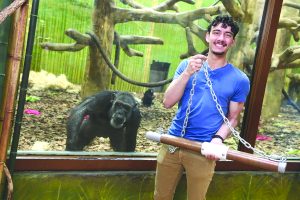
In theory, taking an EKG just requires placing a small plastic-tipped electrodes on a patient’s skin to detect electrical impulses from the heart. But the procedure becomes far more complex when the patients are active, curious chimpanzees—who suffer from similar heart conditions to humans.
The challenge facing Greg Wulffen, a combined BS in mechanical engineering and MS in engineering management student: Design an EKG tool that could be used on chimps at the Maryland Zoo—or, rather, used by the chimps themselves. The zoo’s one requirement: Make it primate-proof.
“The first thing we did when tackling this project was to think of all the ways a chimp might try to destroy it, and focus in on that,” says Wulffen, who inherited the Multidisciplinary Engineering Design project—known as PulseApe—from a team that had started it three years earlier.
Alissa Burkholder Murphy, senior lecturer in the Center for Leadership Education and director of the Multidisciplinary Design program, revived the project last year. She says that Wulffen and Mirza Korman ’23, took the original team’s ingenious prototype to the next level: “They hit it out of the park.”
At issue were the delicate electronics housed at the center of the bar, which were not yet well-protected “from the fingers or teeth of the prying primates.” Using Computer-Aided Design (CAD) software, Wulffen came up with a sheath made of Delrin—a thermoplastic that has a high-fracture toughness—that slides over a cut-out in the center for the electronics and coated the handles with copper. The team then made the entire device wireless, using Bluetooth, and refined the interface so a zookeeper could easily decode and extract the EKG data.
After the zoo confirmed that all materials were safe, the time came to try out the device on the intended subject: an energetic chimpanzee.
“The first run-through overall went well, and we got a reading from one of the chimps,” says Pam Carter, area manager for the Chimpanzee Forest at the Maryland Zoo. “I think we’re the only place getting EKGs this way.”
Wulffen is now using his expertise for a Multidisciplinary Design project at the National Aquarium, where he is part of a team designing a durable, corrosion-resistant device to allow visitors to interact with a new underwater Wetlands Exhibit. This summer, he will take those problem-solving skills to Tesla, where he is interning with the company’s Technical Program Management team.




